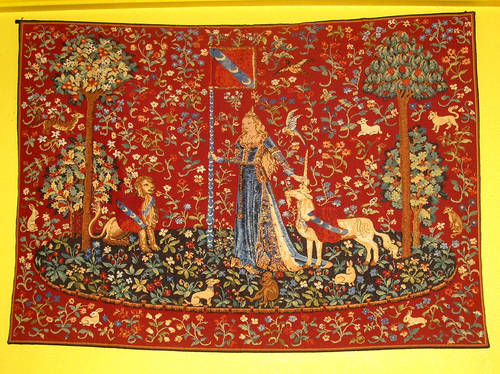HOLY GRAIL Part 3 - Bloodline
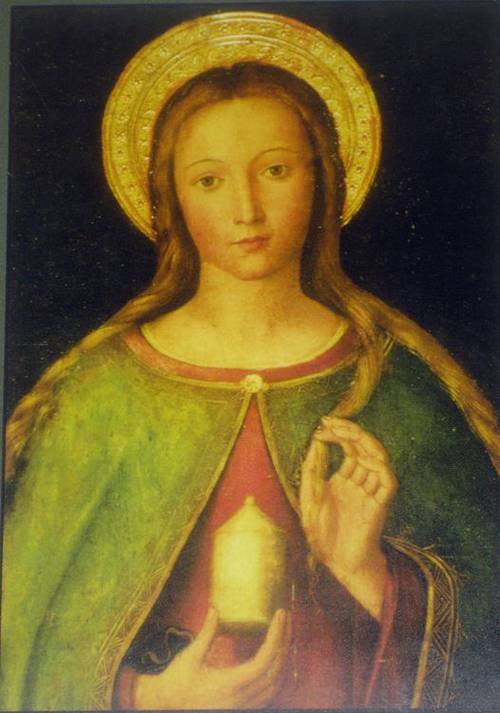 Mary Magdalene with her Alabaster Jar
Mary Magdalene with her Alabaster Jar
But this jar was not the Holy Grail . . .
A trigger, a crack
In England, throughout Anglican church history, Mary Magdalene’s popularity has waxed and waned. At one time, 1552, she and her feast-day of 22nd July were even dropped from the Prayer Book. The reason given was that her identity was in question; she might have been she from whom Jesus cast out Devils. And so, over the years, the world had Mary Magdalene, the apostle of the apostles who saw Jesus on Easter morning, then the 6th century ultimate sinner of Pope Gregory, then the invisible Mary Magdalene of the 16th century.
She was re-instated in the prayer-book but was not canonised by the Roman church until 1969. Officially a saint at last, the popularity of Mary Magdalene increased and people became more interested in her, but she was still not particularly associated with the Holy Grail.
Then references started to creep in.
In the book “At the Table of the Grail,” edited by John Matthews, published in 1984, there is a chapter discussing “the Grail as a bodily vessel.” This was a new concept. Until then the Grail was an actual artifact - a stone, a platter, a goblet.
The book told us that Joseph of Arimathea has with him in his coffin at Glastonbury, two white and silver “cruets” holding the blood and sweat of Jesus. There is a “recurring tradition” that these cruets contained the “offspring” of Jesus; male and female vessels of seed (semen) and blood. These were quoted as examples of the concept of “the Grail as a bodily vessel.”
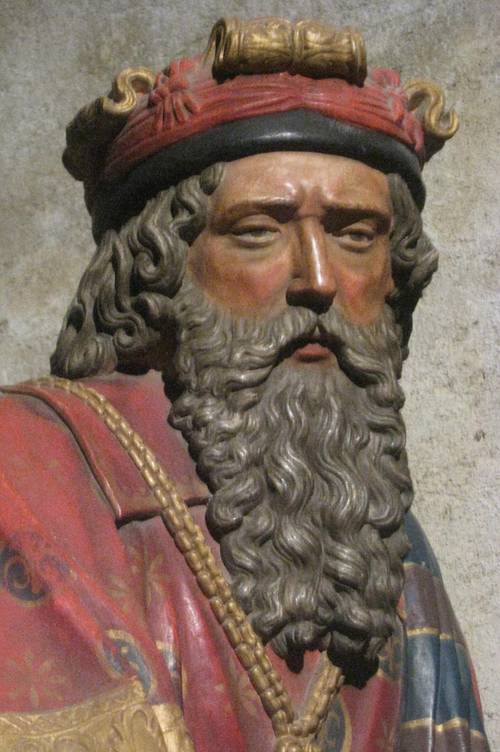
Joseph of Arimathea, shown as an old man,but it's now known he was Jesus's brother.
The supreme example of the bodily vessel idea was the Virgin, who bore the body and blood of the Saviour within her own body. A door had opened. But it was still the Virgin Mary that was associated with the Grail or considered to be the Grail itself.
Eventually, on page 173 of the book, was a brief speculation. Jesus revealed “gnosis” or knowledge to Mary Magdalene. Then it is casually mentioned that the “bodily vessel Grail tradition” suggests “actual children were born to Jesus of Nazareth and they could be the blood of the dark myth-woman of Christianity, Mary Magdalene.” Then - nothing further in this book!
They must have gone to press early for they obviously had not read the book published in 1982 - The Holy Blood and the Holy Grail.
HBHG, as it is known, was an investigation of the Rennes-le-Chateau mysteries, and brought a new surprise; the Holy Grail was the bloodline of Mary Magdalene and Jesus, who had been, according to the Cathars, married; their children lived in Arcadia in Greece (the very place where “Alph the sacred river ran”) and had founded the Merovingian bloodline of France, protected by a secret society.
However, a Frenchman called Pierre Plantard had first written this; he had “fed” the English researchers home-made documents. It’s now known he made the whole thing up. Yet many people think that if they can prove themselves of Merovingian descent, they can prove they have divine or Royal blood, the blood of Jesus himself - even though the Merovingians died out in the 8th century.
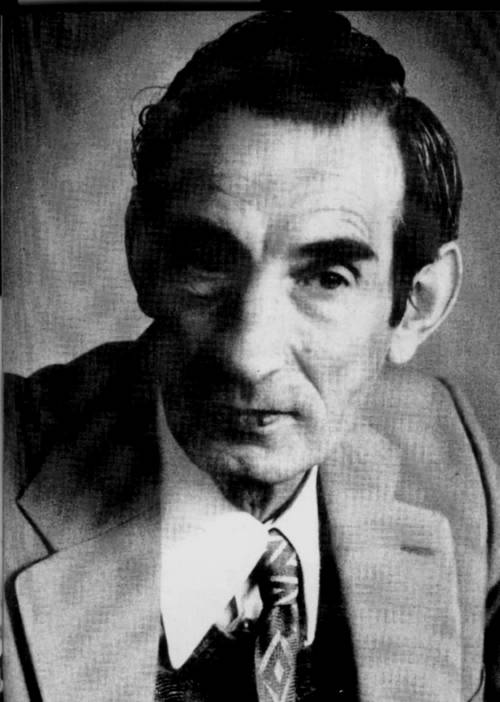 Pierre Plantard
Pierre Plantard
On page 328 of HBHG, towards the end, they conclude that the Grail related to a bloodline originating with Jesus and Mary Magdalene. “According to certain medieval legends, the Magadelene brought the Holy Grail, the Blood Royal, into France. The Grail is closely associated with Jesus.” The Grail was a bloodline. They give no references for these ”certain medieval legends,” but it seems the authors are referring to the many medieval Grail stories, which I don’t think were ever seriously meant to be history but were the “bestsellers” of their day. People did not differentiate then between fact and fiction as we do today.
After HBHG, many people visited Rennes-le-Château, with its church dedicated to Mary Magdalene, and started to think more deeply about her. This church is said to be the key to the proof of Mary Magdalene’s marriage and the bloodline that she founded. Many go there now simply because of her, rather than the mystery of how the priest made his fortune, which once intrigued many. Nearly all the “spiritual tours” for people looking for Mary Magdalene, visit Rennes-le-Château.
The Sacred Feminine
In the 1990’s was published Margaret Starbird’s book, The Woman with the Alabaster Jar. Margaret is a sincere Catholic scholar - the last thing she wanted to be was controversial. She calls the Holy Grail “the most precious treasure of Christianity.”
Margaret Starbird was, however, heavily influenced by HBHG; she mentions it many times and credits it with opening up the whole scenario for her. There is “evidence,” she said, “that the royal bloodline eventually flowed within the Merovingians. The name itself has Mer and Vin - translation, Mary and the Vine!” But vines and/or grapes are commonly assumed to represent Jesus, as he said he was the “true vine.”
When Michael Baigent died in June 2013 Margaret posted on Facebook that HBHG “was the book that launched my quest for the truth about Mary Magdalene and the “Sacred Union” at the heart of the Christian story.” In the book she shows how the feminine was dropped from the Christian story, why its loss has devastated civilisation, and how it can be restored.
Because the French word for Holy Grail, sangraal, had the same pronounciation as sang réal, which means royal blood, Margaret felt compelled to believe that when Mary Magdalene came to the south of France after the crucifixion she was carrying Jesus’s child. Her womb was a cup; Mary Magdalene herself, her woman’s body, was the Holy Grail.
The 1984 concept of “the Grail as bodily vessel” had come to stay as Mary Magdalene.
On page 72 Margaret agrees that “the Cathar’s practice of Christianity had roots both ancient and pure, reflecting the vigour of primitive Christianity at its dawn.” I was particularly pleased someone else had reached this conclusion. See our article, Mary Magdalene and the Cathars.
Margaret says quite frankly; “I cannot prove that Jesus was married or that Mary Magdalene was the mother of his child. I cannot even prove that Mary Magdalene was the woman with the Alabaster Jar who anointed Jesus at Bethany. But I can verify that these are the tenets of a heresy widely believed in the middle ages; that fossils of the heresy can be found in numerous works of art and literature; that it was violently attacked by the hierarchy of the established Church of Rome; and that it survived in spite of relentless persecution.”
Margaret also analyses the medieval unicorn myths. There’s no doubt for her that the lady and her unicorn represent the Bride and his Bridegroom, the mystical marriage between Jesus and his Bride Mary Magdalene. For her the medieval tapestries symbolise the bride and the bridegroom in the Bible’s Song of Songs.
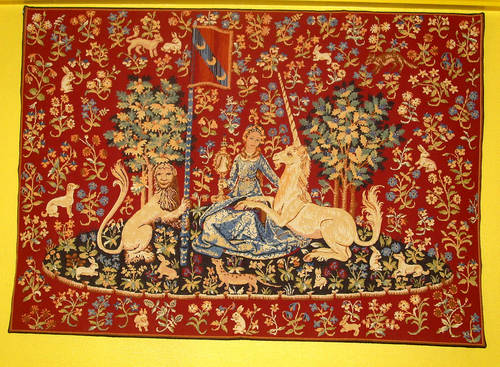
These tapestries hang on the wall of the "Hostellerie" restaurant in Rennes-les-Bains.
She concludes of page 176; "When I first set out to debunk the Grail Heresy in 1985, I had no idea where my journey would lead. In the synthesis of my evidence . . the arguments for the existence of the Lost Bride gradually crystallised. Everywhere I found traces of the lost feminine and the imbalance of opposites that manifests in the image of the wasteland, the crippled king, and the broken-hearted Madonna."
The Gnostic Gospels
Meanwhile, adding greatly to our knowledge and enthusiasm, the Gnostic Gospels or if you prefer, Gospels banned by the newly emerging Roman Church as heretical, discovered in 1945, gave us a new picture of Mary Magdalene as a teacher and apostle, the beloved companion of Jesus. The Gnostic gospels include The Gospel of Mary and Pistis Sophia.
Biblical scholars can date manuscripts by various factors, such as the language used, the current ideas of the day, and so on. The Gospel of Mary was dated second century and could not have been written by Mary Magdalene herself; the name reflected the style of the times, and we would call it the Gospel about Mary.
Pistis Sophia was dated even later, about 250AD. Sophia means wisdom. Anyone with Internet can find and download this gospel. It uses the editorial device of setting an idyllic scene where the evangelists and Jesus debated and taught dogma by a Socratic question-and-answer method. What is amazing is the large role Mary Magdalene played. This makes it quite clear that the early Christians, that is, followers of Jesus’s original Christianity, accepted women initiates who could freely enter or even orchestrate discussions, which was totally against Judaic teaching. But Mary fought hard for this. In Pistis Sophia, she had to defend her position against Peter, but the other disciples supported Mary, because she had such depth of spiritual vision they wanted to share.
These events did not literally happen; the author of Pistis Sophia, just as an author might do today, told a story to communicate his “message.” The story was within the literary tradition of the pre-Constantine early Christians and shows it was thought at the time that women could be priests and that St. Peter disapproved of this. It also shows that the Gnostics believed that Mary Magdalene was Jesus’s best disciple and as wise as he, as well as personally loved by him.
With all this information coming in, some spiritual people decided the Cathars had worshipped Mary Magdalene who had given them her Gnostic teachings. Elizabeth van Buren, who lived at Rennes-le-Chateau, wrote about Mary Magdalene, who gave the Cathars a Great Treasure - the Book of Love written by Mary herself. It was this book that was smuggled out of Montségur, the “cathedral” of the Cathars where great religious secrets were held. The Book of Love is linked to the Gospel of St. John, and is claimed to contain the great secret teachings that Jesus confided to his disciple John. These teachings were so powerful that all hatred, anger and envy would vanish from the hearts of men and women. Divine Love, like a flood, would submerge the world and lead to a New World.
Wonderful moving spiritual words, but Mary Magdalene was never the “high priestess” of the Cathars. Mary Magdalene lived in the time of Jesus, when Montségur didn’t exist. The historical Catharism was never a “love” religion. The troubadours sang of allegiance and erotic love, not spiritual or religious love.
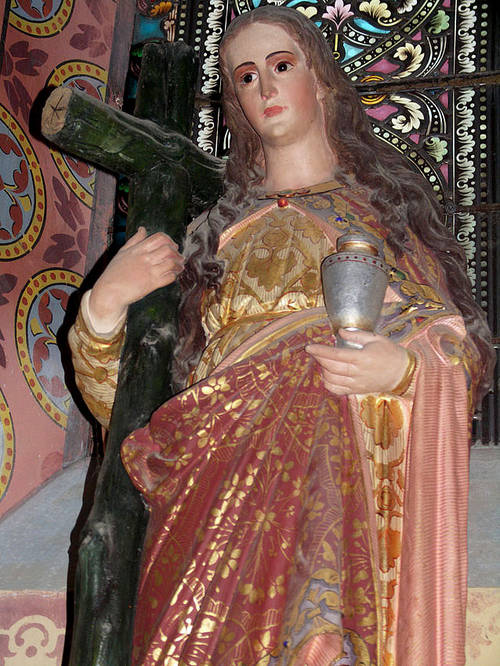 Photo Jaap Rameijer
Photo Jaap Rameijer
Mary Magdalene in Rennes-le-Château church. The cup is not the Grail, but the jar of ointment with which she anointed Jesus.
The Bloodline
What is now capturing everybody’s imagination is the idea of a bloodline. Mary Magdalene and Jesus were married, and had a child or children, and their descendants were still alive today.
The Bloodline became all, and we all avidly read the Lawrence Gardner books, The Bloodline of the Holy Grail, 1996, and the Magdalene Legacy in 2000. He “proved” the bloodline by genealogical research, which, rather conveniently I thought, discovered that the British Royal Family were descended from Jesus and Mary Magdalene. He published a huge genealogical chart which you could hang on your wall, or roll up and keep like a scroll.
On page 206 of the Magdalene Legacy, he says these descendants of Mary Magdalene and Jesus are the desposyni. This is not accurate. The word was coined to cover the blood relatives of Jesus in Judea, the descendants of his half-brothers and half-sisters.
Jesus had 5 brothers, Joseph (Joseph of Arimathea) James, Simon, and the twins, Jude and Thomas. James became the leader of the Jerusalem Church, with his own son, another Jude. Also mentioned in the Bible, but not named, are two sisters of Jesus.
The Bible makes it absolutely clear that while Jesus was the son of the Virgin Mary, his father was not Joseph. Jesus was not of the House of David and thus had no Royal Judaic blood, although his step-father Joseph adopted him. It’s now believed that Jesus was the son of the Virgin Mary and Pantera, as you can read in my article about Quintillan. Jesus carried none of Joseph’s genes. Any offspring of Mary Magdalene and Jesus would not have contained Hebrew Royal blood.
The descendants of the half-brothers of Jesus later became known as the desposyni. NOT the descendants of Jesus and Mary Magdalene.
Sextus Julius Africanus's reference to Desposyni is preserved in Eusebius of Caesarea's Ecclesiastical History. It tells us how Herod had burned all the genealogical records of the family of Joseph. This we can certainly believe - Herod tried to have Jesus killed because the popularity of Jesus among the people threatened Herod’s own position as puppet ruler.
“A few of the careful, however, having obtained private records of their own, either by remembering the names or by getting them in some other way from the registers, pride themselves on preserving the memory of their noble extraction,” wrote Eusebius. “Among these are those already mentioned, called Desposyni, on account of their connection with the family of the Saviour.” Whether this was valid evidence or not, nobody seemed quite sure. “And let this suffice us, for, although we can urge no testimony in its support, we have nothing better or truer to offer." It was a churchman writing, don’t forget.
Eusebius has also preserved an extract from a work by Hegesippus. The extract refers to the period from the reign of Domitian (81–96) to that of Trajan (98–117), and includes that two Desposyni brought before Domitian. “There still survived of the kindred of the Lord the grandsons of Judas, who according to the flesh was called his brother.” (This would have been Jesus’s half-brother Jude or even Jude the son of James, who helped James set up the Jerusalem church after the crucifixion.) “These were informed against, as belonging to the family of David, and Evocatus brought them before Domitian Caesar: for that emperor dreaded the advent of Christ, as Herod had done.
“So he asked them whether they were of the family of David; and they confessed they were. Next he asked them what property they had, or how much money they possessed. They both replied that they had only 9000 denaria between them, each of them owning half that sum; but even this they said they did not possess in cash, but as the estimated value of some land, consisting of thirty-nine plethra only, out of which they had to pay the dues, and that they supported themselves by their own labour. And then they began to hold out their hands, exhibiting, as proof of their manual labour, the roughness of their skin, and the corns raised on their hands by constant work.
“Being then asked concerning Christ and His kingdom, what was its nature, and when and where it was to appear, they returned answer that it was not of this world, nor of the earth, but belonging to the sphere of heaven and angels, and would make its appearance at the end of time, when He shall come in glory, and judge the living and dead, and render to every one according to the course of his life.
“Thereupon Domitian passed no condemnation upon them, but treated them with contempt, as too mean for notice, and let them go free. At the same time he issued a command, and put a stop to the persecution against the Church. When they were released they became leaders of the churches, as was natural in the case of those who were of the kindred of the Lord. And, after the establishment of peace to the Church, their lives were prolonged to the reign of Trajan.”
You must see therefore, that any descendants of Mary Magdalene and Jesus had little to do with the third generation descendants of his half-brothers. Jesus and Mary Magdalene had come to the south of France; it’s unlikely their children would have been in Jerusalem, seventy years later, even if they were very, very distant cousins of the deposyni.
I believe their first child was Sarah - as you can read in my article about Stes. Maries de la Mer. Who Sarah’s descendants were is anybody’s guess, for they would have been considered the offspring of her husband. Anyway, Sarah was never of Royal blood, of the House of David.
All this assumes that Jesus survived the crucifixion; but Gardner doesn’t discuss this, just talks about “dynastic marriages”. He must have been assuming Jesus was Joseph’s son and therefore of the House of David; there’s a flaw in his reasoning here. But read the books for yourselves!
This “proving Royal Blood” idea seems to be important but is it really? The Holy Grail was a SYMBOL for the womb containing the blood of Christ. It was thought that the Virgin Mary was Holy because she carried the “blood” of Jesus, and it’s thought that Mary Magdalene was Holy for the same reason, that she carried the “blood” of Jesus. Within the Christian mind-set of Medieval times, the children of both Mary’s were descended from God himself, they were Holy.
But we know something about DNA nowadays; as far as I know God, the father of Jesus, had no DNA. Mother Mary was bearing a child, not sharing her genes with a God. Later, so was Mary Magdalene. At the time in which they both lived in the Roman Empire, however, there were many mythologies of humans making love with Gods.
It irritates me that the Virgin Mary is considered to be sacred because she had the greatest role ever for a women - she gave birth to, and brought up, the son of God himself. That’s the most favoured woman of all history. We know nothing else about her except that, nothing about what she was like as a person.
Still today, in our society, we give a lot of respect for women who marry rich and famous men. It is a great honour to marry a king or a president and have children by him, but the Virgin Mary had the greatest honour of all, she bore the child of a God.
Now there is talk of Mary Magdalene bearing Jesus’s children. But we don’t want her to be famous for this, do we? While the Virgin Mary’s entire role was as the Holy Mother of God himself, I’m not convinced that we should worship Mary Magdalene because she bore the child of an apparent God. She was such a brave courageous women in her own right; Jesus ought to be remembered as the man lucky enough to be her consort. In the Bible, Mary Magdalene is the only woman NOT defined by her relationship to any man, as his daughter, or mother, or wife.
Think! If Jesus was an ordinary human man, who battled against the Romans, was crucified, survived and escaped to France, then what is the big deal about the “Royal” blood that he impregnated Mary Magdalene with? He was not a descendant of the House of David. If Mary had more than one child by him, then he did not ascend into Heaven and he was not God. Therefore, she cannot be honoured as the woman who bore a “Royal” or “Holy” child. If Jesus was God in the religious sense, then his descendants would have been Holy, except that he wouldn’t have had any. God has no DNA to pass on.
I’m sorry if it upsets people to say so, but Mary Magdalene and Jesus were not Royal or divine people. At the time all these events took place, they did not know that they were Gods.
Even today, when a couple are married the woman takes the husband’s name, and so do the children. So it seems that the “blood” of the father survives, but the blood of the woman does not. The father has a son, who has a son, who has another son, and so on. In some historical genealogies of kings, his wife’s name is not even mentioned, nor where she came from. All the time the bloodline of the father becomes more dilute, and the women and daughters are forgotten.
But Mary Magdalene was so much more than just a mother; she was great for her courage and spiritual insight and was faithful to her education and preaching when, at a later date, St. Peter, who had run and hidden because he thought he might be executed himself, was so irritated with Mary Magdalene that he wanted to kill her. “She is not worthy of life,” he said. The truth is that Mary Magdalene was so magnificent that she frightened people like Peter. Throughout history, men have often been aggressive towards women because they were afraid of them.
Some cultures in history, but very few, have had a legal descent through the woman, it’s called matriarchal descent. We know the ancient Egyptians did it, as sometimes did the Celts, their women certainly had more equality with men than did the women of the Romans or the Jews. Some of the old families in Cathar times did it.
Mary Magdalene and Jesus came to a Gaul in 33AD which was populated by the Celts and the Romans. The two nations traded and so they eventually amalgamated, but this process was far from complete at that time. I suspect Mary and Jesus may well have mixed more with the Celts than with the Romans. The beliefs of the Celts were far closer to the beliefs of Jesus as regards spirituality, for the Celts the “Far World” was closely linked to this world, and some people could pass easily from one to the other.
I don’t want to think of Mary Magdalene as important because she was the lover, or concubine, or wife, of the man called Jesus, and now called the Holy Grail, because she carried Jesus’s child in her womb. Back to square one? The woman admired and honoured because she bore the child of a famous man? Except that he wasn’t famous at the time.
It is patriarchal to think that a woman is important because of the status of the man she bears children for. It’s only recently in historical terms that the woman’s genetic inheritance or DNA has been recognized.
But now there is hope - the discovery of mitrochondrial DNA, which is passed down from mother to daughter, and can be traced back through thousands of years. And the process or tracing it is cheaper. The first popular book about this was written in 2001, Bryan Sykes’s The Seven Daughters of Eve. He was able to trace descent through 6000 years or more - through women.
Similarly, in Canada, some people were able to trace their descent through 6000 years, tracing the mitrochondrial DNA of the women. In today’s scientific climate we are able to do this and it works, scientifically, knowing only who the mother of a child was. And it's a more certain for sometimes one can not be absolutely sure who the father of a child is.
We are at a time in history, for the first time, able to create reliable family trees and bloodlines - through the women, in a matriarchal society. This is surely food for thought for the believers in the “Divine Feminine.”
Summary
The Grail is a symbol of an incredible secret, of eternity and eternal life, the eternal search, the endless quest for meaning, the thrill of finding something outside us and beyond us that includes us and our little lives. Indeed, the sacred feminine could symbolise eternal life for us, like the Celtic Virgin of Chartres, who was perpetually giving birth, over and over, bringing new souls into the world, working at nurturing them, all on her own. That is what so many women do.
We started these three articles with the expression; The Grail exists as a result of the soul’s longing for a solution to the mystery of self-consciousness.
But what do we think the Grail is now, after all the research we have done? What has it to do with Mary Magdalene?
One day in Rennes-les-Bains I had a sort of insight. I was standing on the bridge looking down at the Benitier, where it is reputed that Mary Magdalene baptised people. The river flowing towards me had come from the Source de la Madeleine. It was named after a lady called Madeleine around 1860; before then it was known by its Celtic name, Source of the Cup; the Celtic Cup, always associated with sacred springs guarded by a goddess of the waters. And the cup represented a womb with Jesus’s blood in it, human life began there in the darkness, like being in a warm, moist cave and Mary Magdalene is always associated with caves. These are all Jungian archetypes deep in our subconscious.
It is not Mary Magdalene that is the Grail, but the eternal feminine.
Royal Blood
To me it doesn’t really matter whether anyone’s father was a king or not, but throughout human history, the concept of a God King has gone very deep, it’s only recently, historically, that leaders have been elected and not worshiped because of their descent from other God Kings.
The following film will give you something to think about.
The film is; http://www.youtube.com/watch?v=HfuVEgPqFoA
It expounds the theory that Gods who looked like humans came to earth at a time when human beings were descending from monkeys, hence the humans’ DNA as well as the blood in their bodies carried the Rhesus Factor, named after Rhesus monkeys. The mysterious Gods did not carry this human/monkey factor in their blood - they were Rhesus Negative.
Out of all the people in the world today, the ones with the highest incidence of Rhesus Negative blood, some 40%, are the Basque nation who live in the small area on the western Pyrenees straddling the border between France and Spain. (Among British people the incidence of this blood group is 6%.) The Basques are also the only nation in the world in the world with a unique language that has never been traced or linked to any other languages.
The film concluded that people with Rhesus negative blood are descended from the Gods. If so I personally am twice a goddess, for both my parents were Rhesus Negative. We Rh 0 blood-group people are supposed to be red-haired and psychic. Well, my hair’s red!
You might also like to look at the following film.
http://www.youtube.com/watch?v=FYWD2ERVKyI
It is rivetting to look into the eyes of those people who could be descendants from the Gods and Goddesses. Do you look like them?
Inscrivez-vous au site
Soyez prévenu par email des prochaines mises à jour
Rejoignez les 261 autres membres

